 |
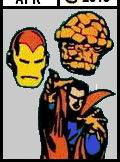 |
|
MARVEL
REPRINT TITLES
OF
THE 1960s
Part
One (1962-1965)
|
|
|
|
| |
|
| |
| |
FACE
FRONT, TRUE BELIEVERS!
It all began on August 8th
1961.
On that day, a comic book
sporting the title The Fantastic Four and
a cover date of November 1961 (cover dates on comic books
were always two to three months ahead of the
actual publication date in order to prolong their
shelf life) hit the newsagents for the very first
time.
The
rest, as they say, is history.
Fantastic Four #1
continues to hold a few unanswered questions as
to the exact circumstances of its creation
(McLauchlin, 2018), making the "big
bang" of the Marvel Universe not unlike the
one to our own habitat - but the
new "Marvel Age of
Comics" was introduced with
a flash, and it was to usher in new and
exciting superheroes and concepts and change the
world of comic books forever.
|
|
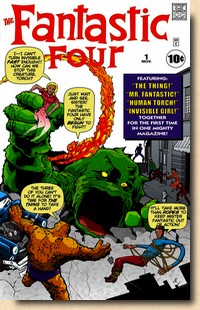
Fantastic Four #1
(Nov 1961)
|
|
| |
| |
FACE
ABACK, TRUE BELIEVERS!
It all began
on July 3rd 1962.
On that day, The
Big Strange Tales Annual #1 hit the newsagents.
Devoid of an actual cover date other than
"1962", it was distributed
along with other Marvel Comics titles
carrying cover dates of September and
October 1962.
The
rest is Marvel Comics publication
history.
Strange Tales
Annual #1 holds the distinction of
being Marvel's first ever annual,
together with The Big Millie the
Model Annual #1, both of which were
published on the very same day. But
unlike the latter, which was made up of
72 pages of "All New
Stories" (as a cover blurb
pointed out), Strange Tales Annual #1
contained no new material at all. Instead, it
repackaged 12 "sci-fi-monster"
stories which had been the staple
contents of Marvel's 1950s "Atlas
era" titles Strange Tales,
Journey Into Mystery, Tales
Of Suspense and Tales To
Astonish.
|
|
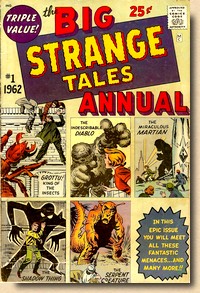
Strange Tales
Annual #1 (1962)
|
|
|
| |
| "Annuals" had
been published since the 1920s, often assembling
previously printed material into a compilation -
Fawcett's Hooey Annual (first published in 1932),
for instance, featured a "collection of the
year's best cartoons". The 1950s saw a growing
number of annuals by various publishers, but the format
was especially popular in the UK and Australia, where the
first DC superhero material annuals (featuring Superman
and Superboy) were published in 1953. DC only put out its
first US market annual in 1960, Superman Annual
#1, followed by Batman Annual #1 in 1961 - both
featuring reprint material from the 1950s. Hailed as an
"epic issue" in its cover blurb, Strange Tales
Annual #1 was actually more of a eulogy to
those five to seven page stories featuring monsters from
outer space (often drawn by Jack Kirby and given double
consonant names by Stan Lee, such as Bruttu, Orrgo and
Zzutak) and supernatural fables (often drawn by Steve
Ditko, Don Heck and Paul Reinman): In the wake of the
success of the new "Marvel Age of
Comics" they had run their course, and now
their titles were given over to superheroes.
When
Strange
Tales Annual #1 went on sale on 3 July 1962, Thor had
already taken over Journey Into Mystery (as of
issue #83, cover date August 1962, on sale 5 June 1962),
Ant-Man had done the same with Tales To Astonish
(as of issue #35, cover date September 1962, on sale 5
June 1962), and the Human Torch would take over Strange
Tales as of issue #101 (cover date October 1962, on
sale 10 July 1962) only a week after Strange Tales
Annual #1 hit the newsagent stands. Tales Of
Suspense would remain the sole sci-fi-monster
sanctuary until Iron Man took over on 10 December 1962,
as of issue #39 (cover date March 1963).
Even
though Marvel's top selling title in 1962 was Modelling
with Millie, it became increasingly clear that more
and more readers wanted superheroes rather than monsters.
But experienced
publisher Martin Goodman knew how to make good money
with reprints from back when he published novel
paperbacks in the 1940s. Back in those days he had had a
few run-ins with the Federal Trade Commission for
"representing
that books or other publications contain original,
complete or unabridged novels, stories or articles when
such is not a fact" (Vassallo, 2014), but he had
learned his lesson. The sci-fi-monsters weren't the
flavour of the day anymore, but with a reduced
expenditure baseline (comic book creators got paid once
and that was it) the profit margin simply was too good
for a seasoned businessman such as Goodman to pass up.
And so Marvel seized the opportunity and put out an
anthology of monster reprints.
It
was the first step in Marvel's long run of reprinting
material and ultimately packaging it in its own dedicated
publication format.
|
| |
| |
"THE MOST REQUESTED
SAGA EVER PRINTED"
It was still early days,
however, for the new Marvel Age of Comics, and
Goodman and Lee were primarily and foremost focusing on
expanding Marvel's range of monthly and bi-monthly
superhero titles. If anything, this called for more new
material, and reprints were thus still something of a
sideline, restricted to the "annual" format.
When
Strange
Tales Annual #2 went on sale on 11 June 1963, it
once again featured 10 sci-fi-monster and supernatural
stories reprints from 1958 and 1959 (taken from Strange
Tales, Strange Worlds and World of
Fantasy), but this time the cover story was a Stan
Lee (script), Jack Kirby (pencils) and Steve Ditko (inks)
Human Torch and Spider-Man story with 18 pages of new
material.
|
| |
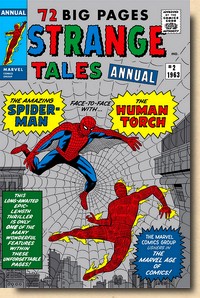
Strange
Tales Annual #2
(1963)
|
|
Of course Strange
Tales had been the Human
Torch's title for more than half
a year by then, so this made
perfect sense. Mixing new
superhero and monster reprint
material made good business sense
too - it drastically reduced the
requirements on original material
needed to produce an annual of 72
pages.
Marvel's
approach to reprinting previously
published material took on a new
direction when yet another
annual, Fantastic
Four Annual #1, went on sale
on 2 July 1963. Together with new
material it also included a
reprint of the first 13 pages of Fantastic
Four #1 (i.e. minus the Mole
Man story), billed on
the cover in Stan Lee's typical
hyperbole as "the most
requested saga ever printed".
It was the
first time Marvel reprinted
material from its recent
superhero output -
even though in this case the
first page was altered to add the
word Origin and the
looks of the Human Torch, the
Thing and Reed Richards were
updated to reflect their
contemporary appearances (which
had evolved quite a bit since Fantastic
Four #1).
|
|
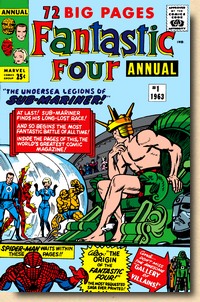
Fantastic
Four Annual #1
(1963)
|
|
|
|
| |
Goodman and Lee were
continuing to test the waters regarding
reprint material through their newly
created annuals. In 1963 Marvel was still
very successfully publishing a whole slew
of titles which featured female main
characters; originally designed as humor
titles somewhat akin to the "Archie
formula", they began to lean more
towards romance content and "girl
interests" in the 1960s.
Published alongside
the flagship and all-new material Millie
the Model Annual, Patsy & Hedy
Annual #1 (which went on sale July 2nd
1963) was made up entirely of material
which had been published previously
between 1958 and 1962 in Patsy
Walker, Patsy and Hedy and Miss
America.
It was only the
second annual ever published by Marvel to
feature only reprint material, following Strange
Tales Annual #1 in 1962. But unlike
the latter title, there would be no more Patsy & Hedy annuals
after the 1963 issue, and Goodman and Lee
would stick with orginal material for
this genre until 1966 (when Millie
the Model Annual #4 would be made up
entirely of reprint material from 1962
and Millie the Model
itself be cancelled in November 1966 with
issue #143).
|
|
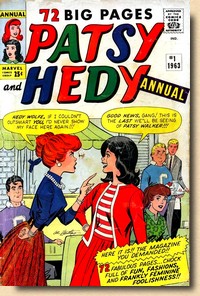
Patsy & Hedy
Annual #1 (1963)
|
|
|
| |
| |
"EXACTLY AS
ORIGINALLY PRINTED - NOT A PANEL OMITTED"
Goodman
and Lee introduced a brand new spin on things when Marvel
published the 72-page anthology Marvel Tales Annual
#1 on June 11th
1964 . Hailed
as a "collector's item" on its cover,
it featured the first appearances of:
|
| |
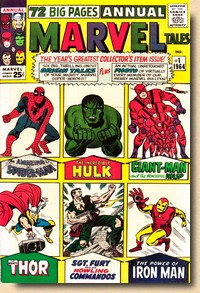
Marvel Tales Annual #1
(1964)
|
|
- Spider-Man (from Amazing
Fantasy #15, August 1962)
- the
Hulk (Chapter 1 from The Incredible
Hulk #1, May 1962)
- Ant-Man
(Tales to Astonish #27, September
1962)
- Giant-Man
(Tales to Astonish #49, November
1963)
- Sgt.
Fury (Sgt. Fury and his Howling
Commandos #1, May 1963)
- Iron
Man (Tales of Suspense #39, March
1963 & Tales of Suspense #48,
December 1963)
- as
well as Thor (Journey into Mystery
#83, August 1962)

|
|
| |
| Marvel
Tales Annual #1 truly kicked off what would
subsequently become Marvel's dedicated reprint title
output - although the word reprint would be
diligently avoided for most of the time at this stage.
Even though published as an annual, there was no ongoing
comic book Marvel Tales; this was not a summer
bumper extra issue, but rather a newly created vessel for
the sole purpose of reprinting previously published
material - and it was Marvel's first. At a very early point
in the publication history of the new Marvel Age of
Comics, the "House of Ideas" was thus enabling
new readers to rediscover the original first appearances
(which often were also the origin stories) which they had
missed when originally published.
Significantly for its own perception and branding, this
included introducing readers to the individuals who
created and produced this as well as the current material
- the "gang in the merry Marvel bullpen" -
by means of a two-page photo gallery featured many
staffers and freelancers alike, including Stan Lee, Don
Heck, Jack Kirby, Sam Rosen, Artie Simek, Flo Steinberg,
Vince Colletta and many others.
|
| |
It made perfect sense
- after all, Stan Lee's friendly and
chatty comments and phrasings (which went
all the way from avuncular to
tongue-in-cheek and over the top) were
essential in creating a sense of
community, which in turn was a big part
of the success Marvel was enjoying.
"What I
always tried to do with Marvel was to
make it seem like a club, like an
inner group that we knew about and
the outside world wasn't even aware
of. If you read Marvel you were on
the inside, you were hip, and it was
sort of an exclusive thing, limited
just to Marvel readers. And I tried
to talk to the readers as if they
were friends, not readers, so that
not only - hopefully - did they enjoy
the stories, but they enjoyed being
part of the Marvel mystique if you
might say." (Stan Lee in NN,
2003)
|
|
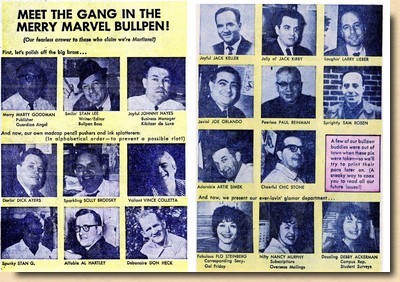
Marvel Tales
Annual #1 (1964)
|
|
|
| |
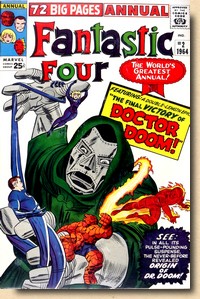
Fantastic
Four Annual #2
(1964)
|
|
For the
September 1964 cover date
publishing cycle (but actually on
sale 2 July 1964), Fantastic
Four Annual #2 again
contained reprint material much
the same way as the first FF
annual had done a year earlier.
As Doctor
Doom featured prominently with a
brand new origin story, it made
perfect sense to slot in a
reprint of Fantastic
Four #5 (July 1962),
featuring the first appearance of
Doctor Doom. It once again made
it easier (and cheaper) for
Marvel to fill the 72 pages of
the annual, but it also provided
readers with an easy access to
earlier but coherent material.
A year later,
for the September 1965 cover date
publishing cycle (but actually on
sale 1 July 1965), Fantastic
Four Annual #3 would contain
even more reprint material, as
the now famous wedding of Reed
Richards and Sue Storm story was
complemented by full reprints of Fantastic
Four #6 (September 1962) and Fantastic
Four #11 (July 1963) - the "2
most requested F.F. issues since
#1", as the cover blurb
put it.
|
|
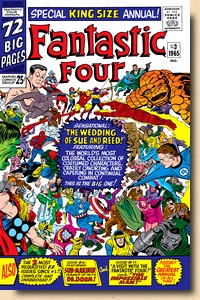
Fantastic
Four Annual #3
(1964)
|
|
|
|
| |

Fantastic
Four Annual #3 (1965)
|
| |
| |
THE WILD
WEST REVISITED
Stories
and characters from the American Old West
frontier started to appear in comic books
in the early 1940s, and the popularity of
these "Western comics" peaked
around 1960 with large parts of the
American public being exposed to a huge
number of Western movies and series on
television.
Before
relaunching the superheroes line for
Marvel in 1961, Stan Lee took the slew of
previously published Atlas Western titles
from the late 1950s and, together with
Jack Kirby and Dick Ayers, gave them an
overhaul. After a hiatus of almost three
years, Marvel relaunched Rawhide Kid
(first published in 1955) with issue #17
(continuing the Atlas numbering) in
August 1960. Almost as though Lee was
test driving his "hero with a
flaw" concept, the Rawhide Kid was
now a short and soft-spoken juvenile fast
gun who was constantly underestimated by
bullying villains. An additional
"flaw" was added when the Kid
wounded a cattle rustler in self-defense,
which in turn led to his life as a
fugitive from the law.
Similar makeovers
were applied to Kid Colt Outlaw and the
Two-Gun Kid (both characters went back to
1948), and the three titles formed
Marvel's "Big Three" of 1960s
Western comics.
|
|
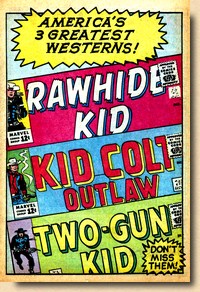
|
|
|
| |
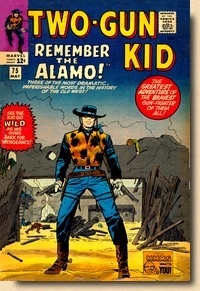
Two-Gun
Kid #75
(May 1965)
|
|
All three
titles had regularly reprinted
2-page text stories from the
1940s which were accompanied by
one or two vignette-type
illustrations (a feature required
in the 1930s and 1940s to qualify
for cheaper postal service
rates), but when Two-Gun Kid #75
went on sale on February 4th
1965 (cover dated May 1965)
readers unwittingly were faced
with a first: a five page back-up
story formerly printed in Rawhide
Kid #34 (June 1963).
It was the
first time since the inception of
the new Marvel Age of Comics
that a regular comic book
(published bi-monthly in this
case) featured reprint material
as part of its regular content.
There was no
cover blurb alerting readers to
any "classic material",
and the only pointer was the
small box on the splash page
reading *FORMERLY
PRINTED IN...
Martin
Goodman had, for the first time,
simply slipped material published
two years prior as a filler into
a regular comic book.
|
|
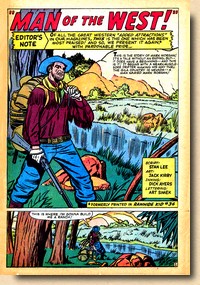
Two-Gun
Kid #75
(May 1965)
|
|
|
|
| |
 |
| |
| It would become a familiar
and proven pattern a few years down the road, and
Westerns - together with Horror stories - would become a
prime mining quarry for reprint material. For the time
being, however, Two-Gun Kid was still
an exception, albeit followed by Kid Colt Outlaw
which would also see the continual use of reprint back-up
stories as of issue #124 (September 1965). |
| |
| |
MORE ANNUALS, MORE CLASSIC
REPRINTS
On
1 June 1965, Marvel published Amazing Spider-Man
Annual #2 as well as Journey Into Mystery Annual
#1 (featuring the Mighty Thor) for the August/September
1965 cover date publishing cycle. While Spidey's first
annual a year previously had featured nothing but
sparkling new material, readers found no less than three
reprints of Amazing Spider-Man #1 (March 1963), Amazing
Spider-Man #2 (May 1963) and Amazing Spider-Man #5
(October 1963) this time around.
|
| |
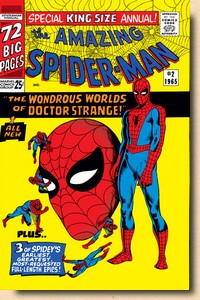
Amazing
Spider-Man Annual #2
(1965)
|
|
Other than
some new "profile
pages" of Spider-Man's
"famous foes", Amazing
Spider-Man Annual #2 thus
only featured 20 pages of
original story material - plus,
as the cover blurb put it, "3
of Spidey's earliest, greatest,
most-requested full-length
epics!".
A similar
formula was applied to Journey
Into Mystery Annual #1 (the
1966 edition would carry on the
numbering but change its title to
Mighty Thor Annual),
although readers got even less
original material here: a new 15
page story plus a double-spread
map of Asgard.
This was
complemented by a total of no
less than five reprints featuring
- as readers were once more told
via a cover blurb - "the
most requested first appearances
of Thor's most deadly foes!"
from Journey Into Mystery
#85 (October 1962), Journey
Into Mystery #93 (June
1963), Journey Into Mystery
#93 (June 1963), Journey Into
Mystery #95 (August 1963)
and Journey Into Mystery
#97 (October 1963).
|
|
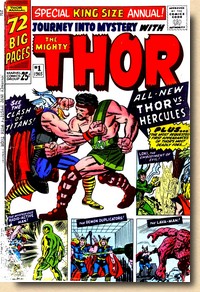
Journey
Into Mystery Annual #1
(1965)
|
|
|
|
| |
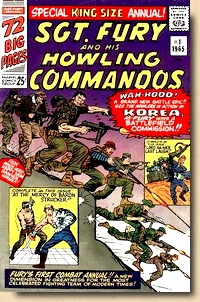
Sgt
Fury Annual #1
(1965)
|
|
A very
similar approach was set to work
with another of the Summer 1965
annuals. Sgt Fury and his
Howling Commandos Annual #1
(on sale 1 June 1965) featured 15
page original story plus a number
of portrait-style pages introducing
the members of the Howling
Commandos, their friends and
enemies, plus their tactical
bases.
This was
backed up by a total of 45 story
pages reprinted from Sgt Fury
#4 (November 1963) and Sgt
Fury #5 (January 1964).
Cover insets pointed to the two
stories with the simple add-on "complete
in this issue" -
possibly the most subtle way of
selling a reprint, but also
cutting it dangerously close to
Goodman's troubles with the Federal Trade
Commission nack in the 1940s.
Inside the
covers, however, reprint material
was always clearly marked as such
with the addition of a box at the
bottom of the first page of every
story, advising readers that the
material was "originally
presented in ...".
|
|
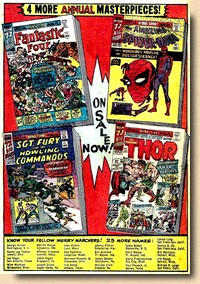
In-house
ad for 1965 annuals
|
|
|
|
| |
 |
| |
| For now,
everybody seemed to be happy: readers got stories they
might have missed, Marvel got an easy way to assemble a
72 page annual, and Martin Goodman got a great way to
sell the same thing twice. |
| |
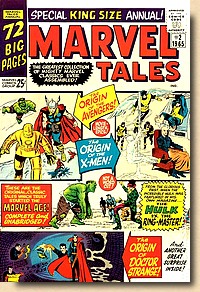
Marvel Tales Annual #2
(October 1965)
|
|
Marvel's next full reprint
title went on sale 3 August 1965 and took full
advantage of this win-win-win formula when Marvel
Tales Annual #2 added yet more "complete
and unabridged" classic material which "truly
started the Marvel Age".
| |
|
|
Spread out over 72
pages readers found complete reprints of X-Men #1
(September 1963), Hulk #3
(September 1962), the origin of Doctor
Strange from Strange Tales #115
(December 1963) as well as Avengers
#1 (September 1963).
Also
included was a totally random 5-page
Lee/Ditko sci-fi/monster story in the
classic Atlas 1950's style from Amazing
Adult Fantasy #8 (January 1962)
which in some ways was the shape of
things to come: in the 1970s Marvel would
put out a slew of horror titles filled
with nothing but 1950s monster reprint
material by Lee, Kirby and Ditko.
|
|
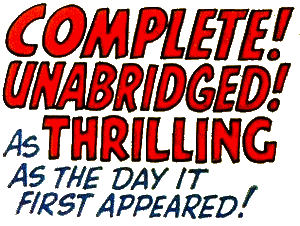 |
|
|
| |
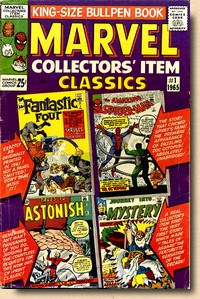
Marvel
Collectors' Item
Classics #1 (1965)
|
|
Marvel's next
full reprint title went on sale
October 5th 1965,
illustrating yet another aspect
of how the House of
Ideas
wanted its reprints to be
perceived by its readers, emphasizing
early material as being
"classic" and
"collectable".
Marvel
Collectors' Item Classics #1
(which was part of the December
1965 cover date distribution
cycle) was an 68-page
25-cent "king-size bullpen
book" reprinting
-
Fantastic Four #2 (first
published January 1962)
- Amazing Spider-Man #3
(July 1963)
- the Ant-Man story from Tales
to Astonish #36 (October
1962)
- plus the first "Tales
of Asgard" featurette
from Journey into Mystery
#97 (October 1963).
The cover of Marvel
Collectors' Item Classics #1
tellingly also spoke of "now
out-of-print classics"
and promised "real
collector's finds"
presented "exactly as
originally printed"
with "not a panel
omitted" (and thus also
including the famous typo from
page eight of Amazing
Spider-Man #3 where Doc Ock
calls Spider-Man "Super-Man").
|
|
|
|
| |
In "A Message form
your Bullpen" (the added exclamation
mark was par for the course with "bullpen
ramrod" Stan Lee) readers were once again
made to feel that they really played a part in
the Marvel Age of Comics - "this one
you're REALLY the editor of!"
It is
hard to say if readers really had been showering
Marvel with requests for this type of comic book
(which was planned as a quarterly publication
acoording to the indicia at the bottom of page
1), but it sold well enough at the newsstands to
secure a subsequent run of 22 bi-monthly issues
before changing its title to simply Marvel's
Greatest Comics in 1969 (after which it
extended its publication run by yet another 74
issues before its demise in 1981).
Back in
the mid-1960s "those grand and glorious
issues" from "the early days
of the marvel Age of Comic" certainly
didn't feel to readers like just any stale old
reprint.
|
|
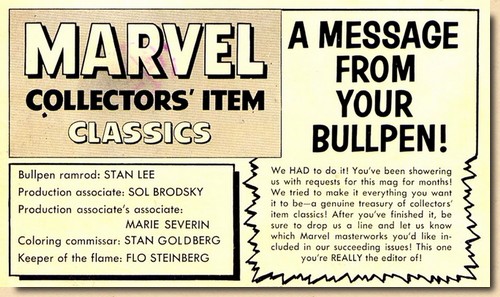
 |
|
| |
As 1966 rolled along,
so did a big conceptual change with regard to reprint
material at Marvel Comics: it became, quite literally, an
ongoing business. Marvel's publisher Martin Goodman "would
notice what was selling, and we'd put out a lot of books
of that type" (Stan Lee in Daniels, 1991),
and based on Goodman's previous experience of making good
money with paperback reprints in the 1940s, he knew
exactly what kind of business opportunity he was looking
at. Better still, Stan Lee had turned the whole concept
on its head by now: when it came to Marvel Comics,
previously published material was now classic and
collectable.
As a result, Marvel proceeded to
create specific reprint titles and slot them into a
regular publication schedule as of 1966.
|
| |